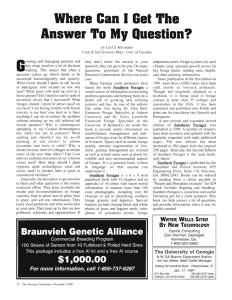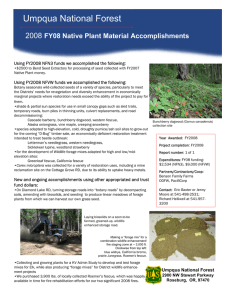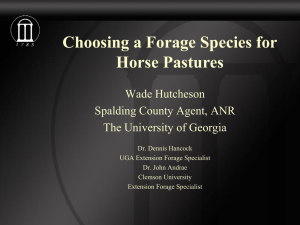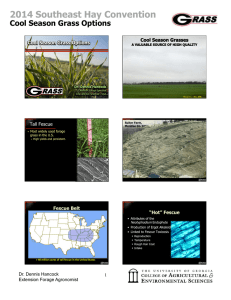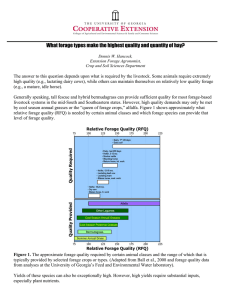Fall forage species and varieties
advertisement
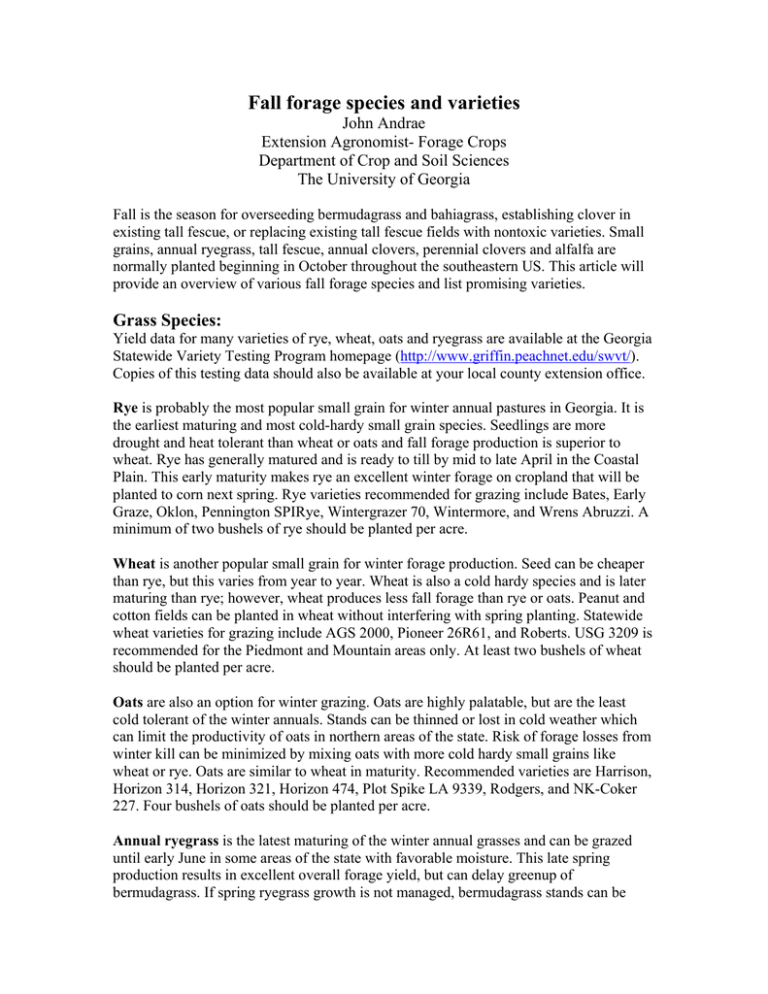
Fall forage species and varieties John Andrae Extension Agronomist- Forage Crops Department of Crop and Soil Sciences The University of Georgia Fall is the season for overseeding bermudagrass and bahiagrass, establishing clover in existing tall fescue, or replacing existing tall fescue fields with nontoxic varieties. Small grains, annual ryegrass, tall fescue, annual clovers, perennial clovers and alfalfa are normally planted beginning in October throughout the southeastern US. This article will provide an overview of various fall forage species and list promising varieties. Grass Species: Yield data for many varieties of rye, wheat, oats and ryegrass are available at the Georgia Statewide Variety Testing Program homepage (http://www.griffin.peachnet.edu/swvt/). Copies of this testing data should also be available at your local county extension office. Rye is probably the most popular small grain for winter annual pastures in Georgia. It is the earliest maturing and most cold-hardy small grain species. Seedlings are more drought and heat tolerant than wheat or oats and fall forage production is superior to wheat. Rye has generally matured and is ready to till by mid to late April in the Coastal Plain. This early maturity makes rye an excellent winter forage on cropland that will be planted to corn next spring. Rye varieties recommended for grazing include Bates, Early Graze, Oklon, Pennington SPIRye, Wintergrazer 70, Wintermore, and Wrens Abruzzi. A minimum of two bushels of rye should be planted per acre. Wheat is another popular small grain for winter forage production. Seed can be cheaper than rye, but this varies from year to year. Wheat is also a cold hardy species and is later maturing than rye; however, wheat produces less fall forage than rye or oats. Peanut and cotton fields can be planted in wheat without interfering with spring planting. Statewide wheat varieties for grazing include AGS 2000, Pioneer 26R61, and Roberts. USG 3209 is recommended for the Piedmont and Mountain areas only. At least two bushels of wheat should be planted per acre. Oats are also an option for winter grazing. Oats are highly palatable, but are the least cold tolerant of the winter annuals. Stands can be thinned or lost in cold weather which can limit the productivity of oats in northern areas of the state. Risk of forage losses from winter kill can be minimized by mixing oats with more cold hardy small grains like wheat or rye. Oats are similar to wheat in maturity. Recommended varieties are Harrison, Horizon 314, Horizon 321, Horizon 474, Plot Spike LA 9339, Rodgers, and NK-Coker 227. Four bushels of oats should be planted per acre. Annual ryegrass is the latest maturing of the winter annual grasses and can be grazed until early June in some areas of the state with favorable moisture. This late spring production results in excellent overall forage yield, but can delay greenup of bermudagrass. If spring ryegrass growth is not managed, bermudagrass stands can be severely thinned from shading. Ryegrass may generate a small amount of forage in late fall when planted on clean-tilled land, but this production is extremely dependent on favorable rainfall and temperature. Ryegrass can be damaged in cold weather, and cold tolerance varies among varieties. Many varieties of ryegrass are commercially available. Select an improved variety with good disease resistance. Some varieties like Passerel Plus and Marshall produce high quality forage late into the spring which can be an excellent characteristic under managed grazing. Other varieties like Bulldog Grazer are earlier maturing and may compete less with bermudagrass during greenup, particularly when pastures are understocked. Many other excellent varieties are listed in the Statewide Variety Test publication which is posted on the internet or is available in your local county extension office. Twenty to thirty pounds of ryegrass should be notill planted or broadcast per acre. Tall fescue is a perennial cool season forage adapted from the Middle Piedmont to the Mountains of Georgia. This species produces the majority of forage during fall and spring months. Unfortunately, a large proportion of existing tall fescue is infected with a toxic fungus which is invisible to the naked eye. This fungus allows the plant to persist under heavy grazing but severely decreases animal reproduction rate and gain. Removing the fungus improves animal performance but shortens tall fescue stand life. Jesup is a good endophyte-free variety that is relatively persistent. AU Triumph is also a good variety that produces excellent amounts of late fall and early spring forage, but is less persistent than Jesup. These fungus-free varieties can be successfully utilized in north Georgia for 4 or 5 years under controlled grazing. MaxQ is a revolutionary tall fescue variety that is infected with a nontoxic fungus. This fungus provides plant persistence of an endophyteinfected variety with animal performance of fungus-free tall fescue. More information on novel endophyte-infected tall fescue is available in the extension publication section of www.georgiaforages.com. Twenty to twenty-five pounds of tall fescue should be planted per acre. Legumes: Crimson clover is probably the most frequently utilized cool season annual legume in Georgia. It has excellent seedling vigor and good tolerance of soil acidity, but does not grow well in poorly drained soils. Crimson clover produces more early spring forage than arrowleaf clover, and varieties differ markedly in their distribution of forage production. AU Sunrise, AU Robin and Flame all tend to produce forage earlier in the season than Dixie. Recommended seeding rate is twenty to thirty pounds per acre. Crimson clover is an excellent species to overseed into warm season sods but offers little when overseeded in tall fescue. Arrowleaf clover is later maturing winter annual than crimson and produces the majority of its forage from mid to late spring. Like crimson clover, this species is best utilized in combination with warm season pastures. Acidic and poorly drained soils greatly decrease arrowleaf clover yields. Arrowleaf clover produces a large proportion of hard seeds and is generally a dependable reseeder. Yuchi is an old and popular variety, but is susceptible to a fungal disease complex that can cause stand failures. Meechee and Amclo are also highly susceptible to these diseases. A new variety called Apache offers improved resistance to these fungal diseases. Keep arrowleaf clover pastures grazed to 2-4". This may help to reduce foliar diseases. Recommended seeding rate for arrowleaf clover is five to ten pounds per acre. Red clover has excellent potential for decreasing fescue toxicosis and improving forage distribution. Red clover persists for one to two years in tall fescue, and produces excellent quality forage into June or even July in favorable years. Red clover also has better seedling vigor than white clover, so it establishes more rapidly and dependably than white clover. Red clover should be rotationally grazed for optimum persistence. Good varieties of red clover include Redland III, Cinnamon Plus, and Bulldog. Cherokee red clover was developed in Florida and is an excellent an annual in south Georgia when fall overseeded into bermudagrass. Eight pounds of red clover should be planted per acre. White clover White clover is an excellent species for poorly drained soils or continuously grazed pastures. White clover can be notill drilled into tall fescue at ¼” to ½” depth or can be broadcast seeded into tall fescue in early spring. For more information on white clover establishment and management visit your county extension office or go to the extension publication section of www.georgiaforages.com. Good varieties of white clover include Durana, Patriot, Regal, Osceola and Will. Regal, Osceola and Will are large “ladino” type white clovers that provide good yields but only persist for two to three years under grazing. Durana and Patriot were selected in Georgia and have excellent persistence under grazing and show promise in bermudagrass pastures in the upper third of Georgia.Two to three pounds of white clover should be planted per acre. Alfalfa is a forage crop that persists well in middle and north Georgia when planted in monocultures; however, this species is less persistent in mixtures with tall fescue or bermudagrass. Small areas of alfalfa can be established for creep grazing or for wildlife food plots. Larger grazing areas can provide high quality forage for growing replacement heifers. Alfalfa requires good soil drainage, pH, P and K. Select a variety with a good disease resistence and grazing tolerance. Two UGA developed varieties perform well in the upper portion of the state: Alfagraze and Bulldog 505. Less dormant varieties developed by UGA green up earlier in spring and produce later in the fall and are well suited for the lower portion of Georgia: Amerigraze 702 and Bulldog 805. Twenty to twenty-five pounds of alfalfa should be planted per acre. Summary Establishing and managing cool season forages during fall months can decrease hay needs and improve overall forage quality and animal performance. Consider establishing one of the above forages on your farm to capitalize on these advantages.
